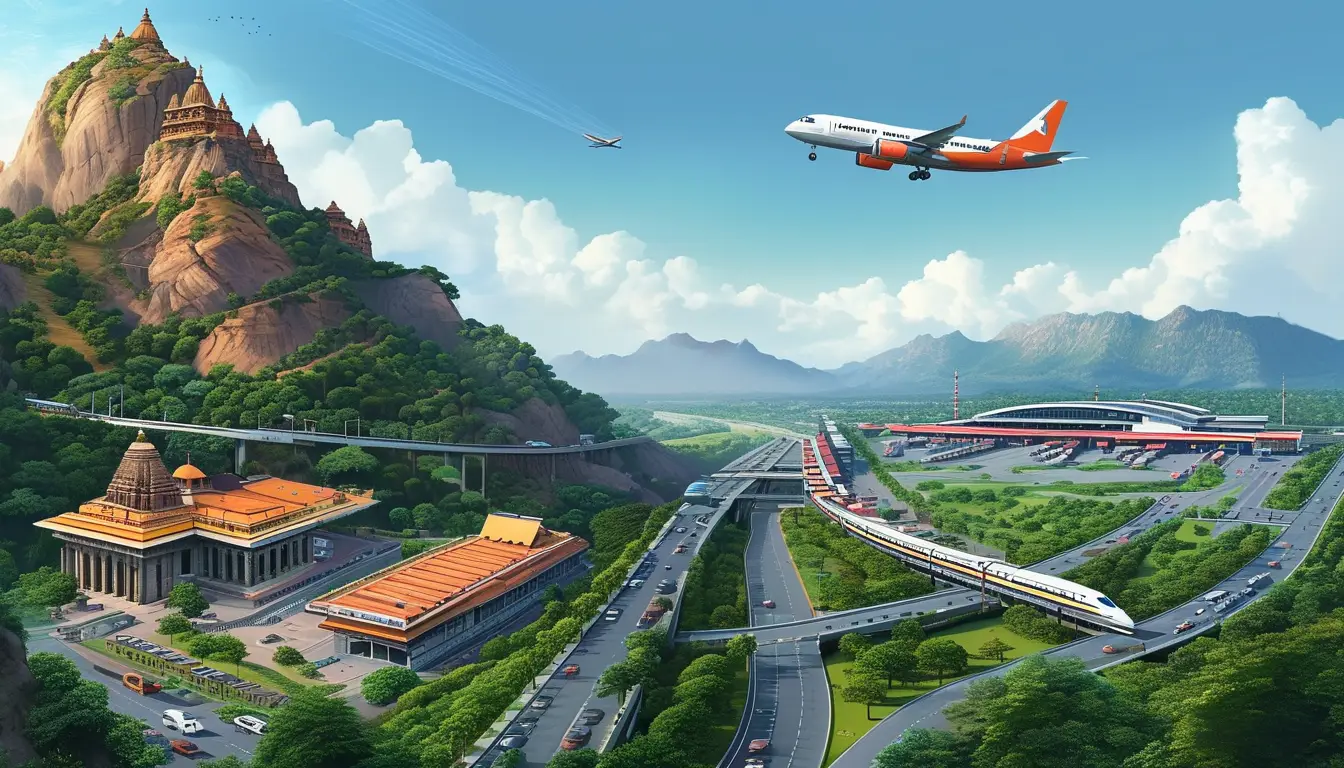Kaziranga Like Never Before: Your Ultimate Wildlife & Hidden Gems Itinerary from the Best Kaziranga Guide
- Quick Read: The Best Kaziranga Guide at a Glance 🚀
- I. Unveiling Kaziranga: A Sanctuary of Giants and Serenity ✨
- II. Best Kaziranga Guide to Safari Timing🗓️
- III. Navigating the Wild: Your Best Kaziranga Safari Adventure 🚙🐘
- IV. Beyond the Safari: Hidden Gems from the Best Kaziranga Guide 💎
- V. Where to Stay: Lodging Tips from the Best Kaziranga Guide 🏡
- VI. Getting There: Travel Routes in the Best Kaziranga Guide ✈️🚂🚗
- VII. Capturing the Magic: Photography Tips from the Best Kaziranga Guide 📸
- VIII. Responsible Tourism: Preserving Kaziranga's Legacy 💚
- Conclusion: Why the Best Kaziranga Guide Leaves You Transformed ✨
Get ready to discover Kaziranga National Park, a true gem nestled right in the heart of Assam, India. This incredible place isn’t just a park; it’s a living, breathing testament to nature’s resilience and a shining example of conservation success that the whole world celebrates. ✨ As a UNESCO World Heritage Site , Kaziranga draws folks from all corners of the globe, and for good reason! It’s famously known as the world’s primary sanctuary for the magnificent Greater One-Horned Rhinoceros. 🦏 But trust me, Kaziranga’s magic goes way beyond its iconic rhinos. It’s a vibrant tapestry of diverse wildlife, jaw-dropping landscapes, and rich cultural experiences that come together to create a journey you’ll never forget.
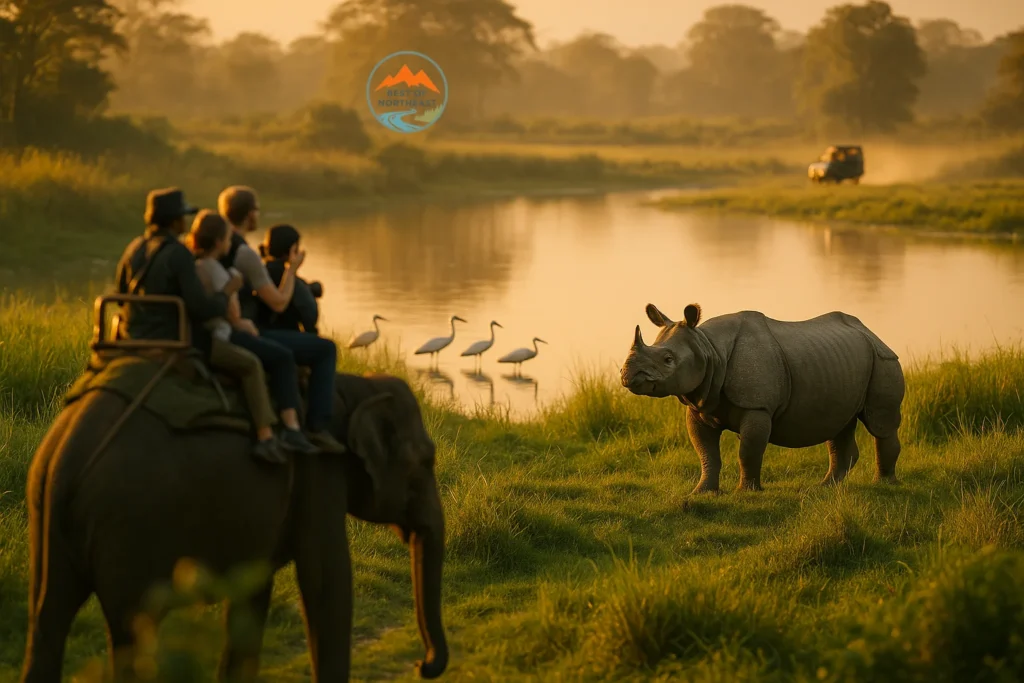
This comprehensive Best Kaziranga Guide is designed to be your personal roadmap to Kaziranga National Park. If you’re short on time, jump straight to our Quick Read section below for the essentials. For those ready to dive deep, our Detailed Guide will give you all the practical insights and insider tips, drawing from the countless stories of travelers who’ve been absolutely captivated by its wild beauty. We’ll explore the park’s ecological wonders, figure out the perfect time for your visit, explore all your safari options, and uncover a myriad of enriching activities waiting for you. So, let’s get you ready for an adventure of a lifetime! 🗺️
Quick Read: The Best Kaziranga Guide at a Glance 🚀
Got just a few minutes? Here’s the lowdown on why Kaziranga National Park should be your next adventure!
- What is Kaziranga?
- A UNESCO World Heritage Site and a global conservation success story.
- Home to nearly two-thirds of the world’s Greater One-Horned Rhinos 🦏.
- Spot India’s “Big 5”: One-horned Rhino, Asiatic Elephant, Wild Water Buffalo, Eastern Swamp Deer, and the elusive Bengal Tiger 🐅.
- A paradise for birdwatchers, with over 479 species, including many migratory birds 🐦.
- Best Time to Visit:
- November to February: The Golden Window! ☀️ Cool, dry weather, peak wildlife sightings, and perfect for migratory birds.
- March to April: Spring’s Embrace 🌸. Warmer, lush greenery, baby animals, and fewer crowds. Great for photographers as rangers burn grass for better visibility.
- May to October: Park is closed due to heavy monsoon rains and flooding ☔.
- Safari Adventures:
- Jeep Safari: Roar through the wild! 🚙 Cover more ground, explore 4 distinct zones (Kohora, Bagori, Agaratoli, Burapahar), and increase your chances of spotting the Big 5. Lasts about 2 hours.
- Elephant Safari: The Majestic Perspective! 🐘 Get up close and personal with rhinos as you gracefully weave through tall grasslands. Available early mornings in Kohora and Bagori ranges. Advance booking is essential!.
- Beyond the Safari:
- Immerse yourself in local culture at the Kaziranga Orchid and Biodiversity Park 🌺, showcasing orchids, traditional dances, and local crafts.
- Wander through serene Tea Gardens ☕ and even spot rare Gangetic River Dolphins on a Brahmaputra River cruise 🐬.
- Explore hidden gems like Kakochang Waterfalls 🏞️ and the Hollongapar Gibbon Sanctuary 🐒.
- Personal Experience Tip: Even if the elusive tiger remains hidden, the sheer vastness and the feeling of being in such a wild, untouched place will leave you with a profound sense of awe. As one traveler put it, “the place just feels right. You’re left with enjoying the vast openness and the feeling that it just wasn’t the right day, but you’ll be back”. The views are truly mind-blowing! 🤯
Ready for the full story? Keep scrolling for our detailed guide! 👇
I. Unveiling Kaziranga: A Sanctuary of Giants and Serenity ✨
A. The Heart of Assam: Location & Landscape 📍
Kaziranga National Park is perfectly positioned within the Golaghat and Nagaon districts of Assam, India. Imagine this: its northern edge is naturally carved out by the mighty Brahmaputra River, while the rolling Karbi Anglong Hills cradle its southern side. This unique spot, where the Australasia and Indo-Asian flyways meet, is a huge reason why the park boasts such incredible biodiversity.
The park’s landscape is a dynamic and visually stunning masterpiece. Think vast, wet alluvial tall grasslands, dotted with countless shallow water bodies (locals call them ‘beels’) fringed with reeds, and sprinkled with patches of deciduous to semi-evergreen woodlands. This vibrant ecosystem isn’t static; it’s constantly being shaped by the annual dance of the Brahmaputra River, with its floods and sedimentation processes. These yearly floods and the rich alluvial soil the Brahmaputra deposits aren’t just natural events; they’re active ecological processes that are absolutely crucial for sustaining the park’s wet alluvial grasslands.
And these grasslands? They’re vital homes for the park’s unique wildlife, including our beloved one-horned rhino. So, the river isn’t just a boundary; it’s like the park’s biological engine, constantly creating and renewing habitats.
Plus, those Karbi Anglong Hills? They’re a critical natural refuge for animals when the waters rise, showing just how interconnected the floodplain and higher ground truly are. This intricate dance highlights the delicate balance and profound importance of maintaining the natural hydrological cycles of major river systems for biodiversity conservation.
Messing with the Brahmaputra’s flow could have huge negative consequences for Kaziranga’s ecosystem, potentially jeopardizing its UNESCO World Heritage status and all the diverse species it protects. This isn’t just about geography; it’s about understanding the park’s complex ecological heart and the conservation challenges it faces. It really shows you the deep human dimension of conservation, where community spirit and political will are just as important as scientific know-how.
B. The Rhino’s Realm: A Conservation Triumph 🏆
Kaziranga National Park is world-famous for its incredible role in saving the Greater One-Horned Rhinoceros (Rhinoceros unicornis). It’s home to nearly two-thirds of the world’s population, with over 2,000 of these magnificent creatures calling it home! Imagine a creature weighing almost three tonnes, taller than an average human – that’s our rhino! These rhinos are semi-aquatic, loving life in swamps, forests, and riversides, where they gracefully graze on grasses using their prehensile lips. And despite their immense size, they’re surprisingly good swimmers! 🏊♀️ Their journey, from a mere 200 individuals in the early 20th century to over 2,000 today, is nothing short of a remarkable conservation success story.
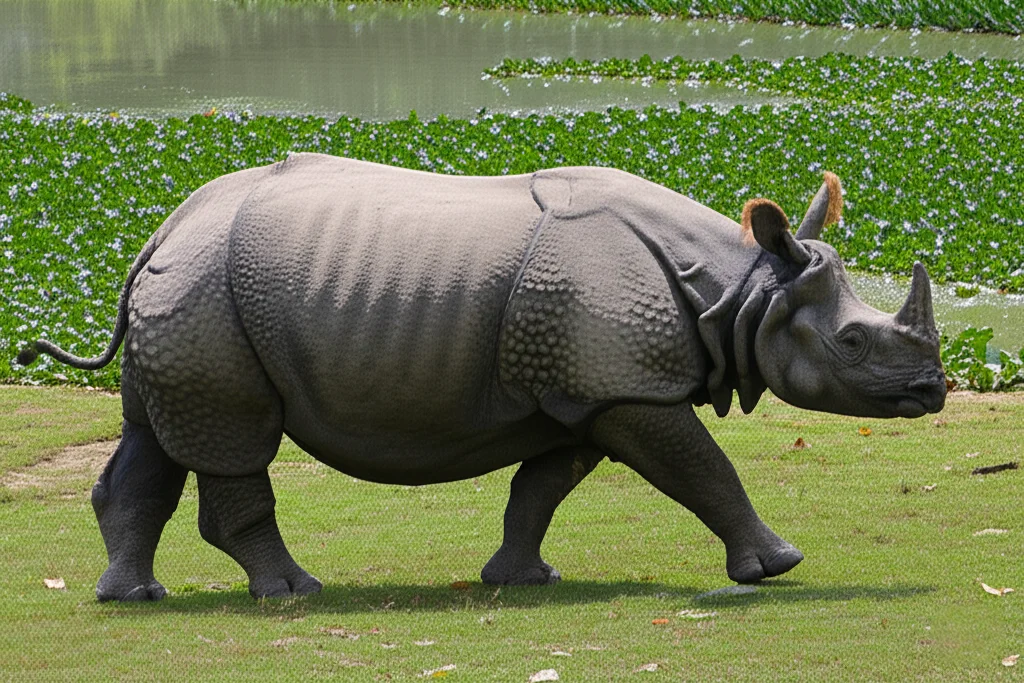
The rhino’s comeback in Kaziranga is a fascinating tale, far more nuanced than just “strict protection.” Back in 1948-1974, they actually started with an inclusive approach, allowing local graziers and fishers near the sanctuary’s edges to build community loyalty for rhino protection. This community-friendly strategy helped the rhino population bounce back early on.
But then, the 1950s and 60s brought tough times – floods and erosion caused agrarian and ecological distress, leading to more landlessness and poverty among local peasants. Sadly, some turned to poaching rhinos for their horns. These illegal killings sparked outrage among the Assamese middle-class, who saw the rhino as a powerful symbol of their identity. This public outcry, mixed with other socio-political concerns, led to a big shift: a move towards exclusive, armed protection, with traditional resource use being banned.
This transformation shows us that conservation policy isn’t set in stone; it adapts to changing pressures and evolving cultural values. It’s a critical lesson for conservation worldwide: effective wildlife protection often needs flexible strategies that balance human-wildlife coexistence with strong enforcement, all while respecting the cultural significance of species. It truly highlights the profound human element in conservation, where community engagement and political will are just as vital as ecological science.
Beyond the iconic rhino, Kaziranga is a recognized “Hotspot of Biodiversity” and proudly hosts India’s “Big 5” wildlife: the one-horned rhino, Asiatic elephant, wild water buffalo, eastern swamp deer, and Bengal tiger. Did you know the park boasts the world’s largest population of wild water buffalo? 🐃
And it holds the incredible distinction of having the highest density of tigers among protected areas globally, with 21 tigers per 100 sq km! 🐅
For all you birdwatching enthusiasts, Kaziranga is an absolute paradise, recognized as an Important Bird Area by BirdLife International. It’s home to over 479 species of birds, including countless migratory and globally threatened species. The sheer number and diversity of these globally significant and threatened species—like rhinos, tigers, wild buffalo, eastern swamp deer, and migratory birds—tell us that Kaziranga’s ecosystem isn’t just diverse; it’s exceptionally robust and healthy in supporting these populations.
This goes beyond a simple count; it signifies the park’s profound ecological integrity and its critical role as a refuge for species facing threats elsewhere. This high concentration of diverse and endangered species elevates Kaziranga’s importance beyond regional tourism, establishing it as a global conservation benchmark and a vital genetic reservoir. Its success in protecting these species has a ripple effect on global biodiversity, making it a model for other protected areas worldwide.
II. Best Kaziranga Guide to Safari Timing🗓️
Choosing the perfect time to visit Kaziranga National Park can truly make your safari experience unforgettable. The park’s seasons play a huge role in how much wildlife you’ll see, what the weather will be like, and how many other visitors you’ll encounter.
A. The Golden Window: November to February ☀️
This period is hands-down the most popular and favorable time to visit Kaziranga National Park. The weather is wonderfully cool and comfortable, with average temperatures ranging from 15°C to 27°C, making it ideal for those long, exciting safaris. Clear, dry skies during these months mean maximum visibility, giving you excellent chances for spotting wildlife.
Wildlife sightings are at their absolute peak during this time. Animals, including the iconic rhinos, majestic elephants, and even those elusive tigers, are more active and frequently seen as they come out to bask in the sun or gather near receding water bodies. This season is also prime for birdwatching, with countless migratory birds gracing the park’s wetlands and grasslands 🐦. Many travelers rave about the crisp morning air on an elephant safari, the golden light filtering through the tall grass, and the sheer number of rhinos grazing peacefully – it truly creates indelible memories. Even with more visitors, Kaziranga’s vastness often allows you to feel completely immersed in the wild.
While it offers the best wildlife viewing, November to February is peak tourist season, so expect more crowds and potentially higher accommodation prices 💸. My advice? Book well in advance to secure your preferred dates and lodging!
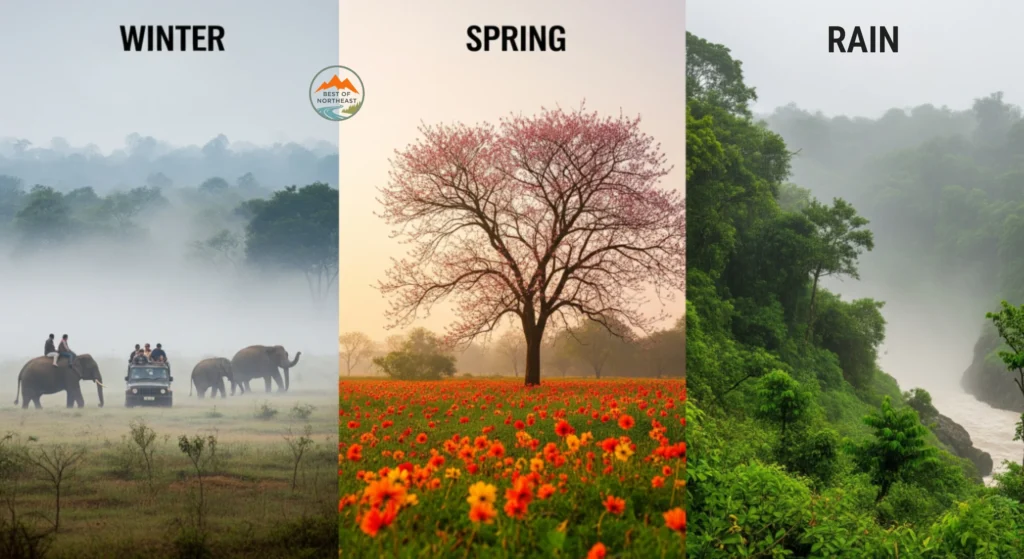
B. Spring’s Embrace: March to April 🌸
Spring offers a distinct yet equally rewarding experience for you. Temperatures gently climb, ranging from 25°C to 30°C in March and April , and the park transforms into a breathtaking canvas of lush greenery. This period remains excellent for safaris and birdwatching, and it’s particularly special for spotting baby animals, as it’s breeding season for many species! 🍼
Compared to the bustling winter months, March and April typically see moderate crowd levels. This means a more tranquil safari experience, allowing for more intimate wildlife observations. A cool management practice during this time is the controlled burning of tall grass by park rangers in late February and March. This deliberate ecological technique clears out old, dense vegetation, which in turn encourages fresh, nutritious shoots for herbivores and significantly improves visibility for spotting wildlife, including those more elusive tigers! 🐅 This proactive approach benefits both the ecosystem (through nutrient cycling and fresh fodder) and your tourism experience by enhancing sightings. The changing light and more open grasslands also make this an excellent time for photographers seeking dramatic and vibrant shots 📸. Many travelers recall the landscape feeling incredibly vibrant during this time, with new shoots emerging after the grass burning, and the quieter atmosphere allowing for more profound wildlife encounters.
C. Monsoon’s Retreat: Why May to October is Off-Limits ☔
From May to October, Kaziranga National Park closes its doors to visitors. This closure is a direct result of the heavy monsoon rains and the subsequent flooding from the Brahmaputra River, which makes large parts of the park inaccessible.
The seasonal closure during monsoon isn’t just an inconvenience; it’s a critical ecological necessity that allows the park’s ecosystem to rejuvenate and provides a natural refuge for its wildlife. The flooding, while it stops human access, is an essential natural process for the park’s wetland ecosystem. It replenishes water bodies, enriches the soil with alluvial deposits, and allows the tall grasses to regenerate without human disturbance. During this time, animals naturally move to higher ground in the Karbi Anglong Hills to escape the rising waters. While this migration is a crucial adaptation for their survival within the park’s natural cycle, it can also make them vulnerable to poaching outside the protected boundaries. Wildlife sightings are severely limited during these months, and no safaris are available. The vulnerability of animals during seasonal flooding highlights a significant management challenge: ensuring safe corridors and protection outside the park boundaries during these months. This really points to the need for broader landscape conservation efforts beyond the park’s immediate borders.
Here’s a quick overview of Kaziranga’s seasons to help you plan your visit perfectly:
Kaziranga Seasons at a Glance
| Season | Months | Average Temperature | Weather Conditions | Pros | Cons | Safari Availability |
|---|---|---|---|---|---|---|
| Winter | November – February | 15°C – 27°C | Cool, dry, clear skies | Ideal for wildlife sightings (rhinos, tigers, elephants), migratory birds, safaris | Higher crowds, potentially more expensive accommodations | All zones fully operational (Jeep & Elephant) |
| Spring | March – April | 25°C – 30°C | Warm, gradually rising temperatures | Lush greenery, baby animals, fewer tourists, excellent for photographers (grass burning) | Increasing temperatures as April progresses | All zones open (Jeep & Elephant) |
| Monsoon | May – October | 28°C – 35°C | Heavy rains, flooding | Very quiet, peaceful environment (from afar) | Park closed, no safaris available, limited wildlife sightings | Park closed due to flooding (No safaris) |
III. Navigating the Wild: Your Best Kaziranga Safari Adventure 🚙🐘
Experiencing Kaziranga’s wilderness is all about its famous safari options, each giving you a unique peek into the park’s diverse ecosystems and amazing inhabitants.
A. Choosing Your Ride: Jeep vs. Elephant Safari 🤩
Jeep Safari: Roaring Through the Wild 💨
Jeep safaris are a super popular and exhilarating way to explore Kaziranga National Park! They let you cover a larger area and tackle that rugged terrain with ease. These safaris are especially great for spotting the park’s “Big 5” – big cats, rhinos, and elephants. A typical jeep safari lasts about 2 hours, giving you plenty of time to soak it all in.
Jeep safaris run twice daily, with morning slots generally from 7:00 AM to 11:30 AM (including various timings like 7:30-9:30 AM and 9:30-11:30 AM) and afternoon slots from 1:00 PM to 4:30 PM (with timings such as 1:30-3:30 PM and 2:35-4:35 PM).
The park is divided into four main zones for jeep safaris, and each one offers a unique experience:
- Kohora (Central) Range: This is the most prominent and frequently visited area, famous for its rich wildlife, diverse landscapes, and exceptional birdwatching opportunities 🐦. It’s a prime spot for observing one-horned rhinoceroses grazing in vast grasslands and majestic herds of elephants.
- Bagori (Western) Range: Many consider this a premier zone for wildlife sightings, especially for its high density of rhinos, as well as elephants, swamp deer, and wild buffalo. This range is known for its picturesque marshlands and lush greenery – truly beautiful.
- Agaratoli (Eastern) Range: This zone is a paradise for birdwatchers and adventure lovers! It’s celebrated for its untouched natural beauty, dense bushy forests, and the exciting potential for tiger sightings 🐅. Just a heads-up, elephant safaris aren’t available here, so jeep safaris are your exclusive way to explore this part.
- Burapahar (Ghorakati) Range: This zone stands out with its hilly terrain and dense greenery, making it particularly appealing to bird lovers. You’ll have excellent chances to spot primates like Hoolock Gibbons and Capped Langurs here 🐒. It’s generally quieter with fewer visitors, offering a more serene experience.
Many travelers describe their jeep safari as absolutely exhilarating. The sheer scale of the grasslands, the occasional splash as a rhino wallows in a ‘beel,’ and the constant thrill of anticipating a sighting create unforgettable moments. The collective excitement within the jeep is palpable every time a guide points out a herd of wild buffalo or a distant elephant. The dusty trails and the open-air vehicle truly help you feel a deep connection with the wild environment.
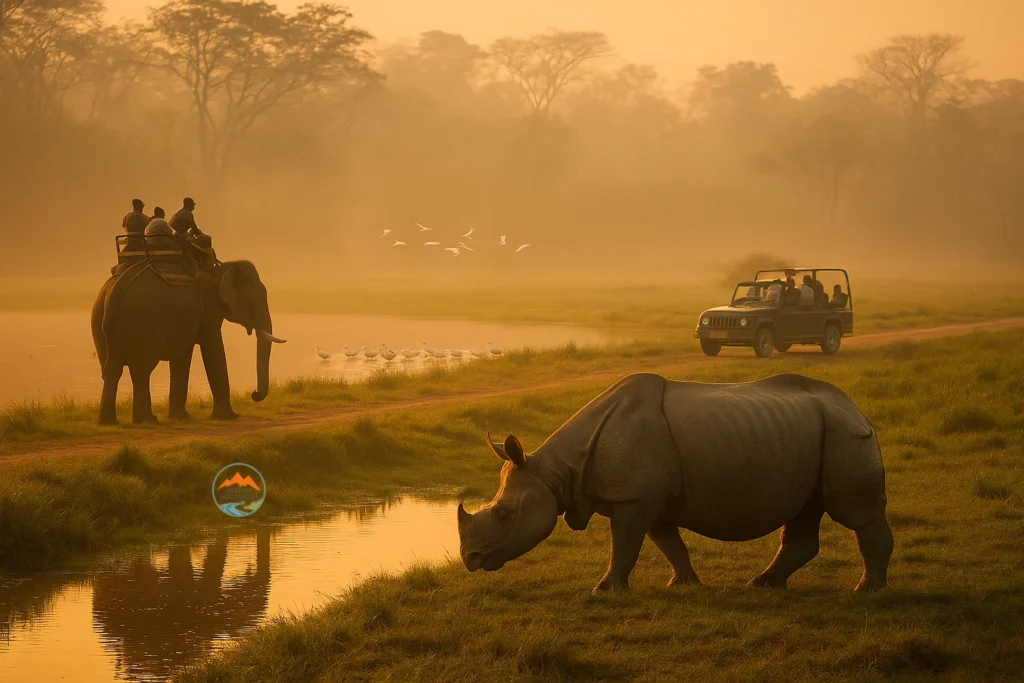
Elephant Safari: The Majestic Perspective 👑
Often called the “Ride of the Kings,” elephant safaris offer an unparalleled, close-up view of wildlife, especially those incredible one-horned rhinos! 🦏 Riding high atop these gentle giants, as they gracefully weave through tall grasslands, gives you a distinct and majestic perspective that jeep safaris simply can’t replicate.
Elephant safaris are exclusively held in the early morning, starting as early as 4:30 AM, with scheduled sessions from 5:00-6:00 AM and 6:30-7:30 AM. These safaris are limited to the Central (Kohora) and Western (Bagori) ranges. It’s good to know that foreign nationals and VIPs are often restricted to the Central range for elephant safaris, while Indian nationals typically go to the Western range.
Because there are limited slots for elephant safaris, advance booking is essential. It’s often recommended to book through your hotel or directly at the park. Just a little tip: slots are sometimes assigned only the night before the safari, so be flexible! For many, the early morning elephant safari is the highlight of their visit. Perched high above the grass, visitors often say they feel like explorers from a bygone era, getting incredibly close to rhinos as their massive forms blend with the morning mist. The profound silence, broken only by the rustle of grass and the elephant’s gentle footsteps, creates a truly privileged encounter – a sentiment echoed by countless travelers who describe it as “mind-blowing” and a “must-visit” experience! 🤯
B. Essential Safari Tips & Booking Guide 📝
To ensure you have a smooth and rewarding safari experience in Kaziranga, a little planning and following park guidelines go a long way!
Advance Booking 🗓️
Securing your permits and accommodations well in advance is super important, especially if you’re visiting during the peak season (November-February). It’s a smart move to book 2-3 months before your trip to make sure you get your preferred zones and timings. The need for advance booking and limited slots, especially for elephant safaris, really shows how popular this place is and how the park management carefully controls visitor numbers in the core safari zones to minimize ecological impact. The dynamic allocation system for elephant safari slots, sometimes assigned only the night before, suggests they’re optimizing for animal welfare or demand distribution. This means meticulous planning isn’t just a suggestion; it’s a prerequisite for a successful trip, and a little flexibility might be needed for specific safari types or timings. It also reinforces the park’s commitment to conservation by implicitly limiting access to protect its precious wildlife.
Permit Fees & Charges 💸
- Entry Fee: For Indian nationals, it’s around ₹100 per person, and for foreigners, it’s approximately ₹650-₹700.
- Jeep Safari Prices: Prices vary by zone and nationality. For Indian nationals, a jeep safari typically costs around INR 4000-4600 per jeep. For foreigners, expect to pay between INR 7700-9700 per jeep. These prices usually cover permit charges, driver fees, and jeep charges, so no hidden surprises there!
- Camera Charges: A small fee, like ₹100 for a DSLR camera, might apply.
- Guides: Only registered guides are allowed inside the park. Guides typically cost around ₹700-₹1000 and can significantly enhance your understanding of the park’s ecology and wildlife.
The safari pricing structure and booking complexities, including different fees for locals versus foreigners and additional charges, reflect a multi-layered approach to park revenue. The tiered pricing is common in Indian tourism, likely making domestic tourism more accessible while generating higher revenue from international visitors. However, the presence of potentially negotiable or less transparent charges, like those for cameras or road tax, or even reports of drivers asking for higher prices, can sometimes lead to confusion. This might be a side effect of the community-driven initiatives managing jeep safaris, where standardization could be less rigid. This suggests that while the park aims for accessibility, the booking experience can be inconsistent. For a truly hassle-free travel experience , clearer, standardized pricing and booking procedures across all safari operators would be a welcome change, potentially managed more centrally to build greater trust and improve visitor satisfaction, especially for first-time visitors.
What to Pack 🎒
- Clothing: Stick to neutral colors (khakis, greens, browns) to blend in with nature 🌿. Layers are a great idea to handle varying temperatures, especially during those cool mornings.
- Essentials: Binoculars are an absolute must for enhanced wildlife viewing 🔭. Don’t forget sunscreen, insect repellent, and a reusable water bottle to minimize plastic waste and stay comfy.
- Photography Gear: A telephoto lens (at least 400mm focal length) is essential for capturing distant wildlife without disturbing them 📸, while a shorter lens is handy for those breathtaking landscapes. Bring backup batteries and chargers – you don’t want to miss that perfect shot!
Respecting Park Rules and Wildlife 🙏
It’s super important to remember: you are strictly prohibited from getting out of your jeep or off your elephant during the safari. Feeding animals or littering inside the park is also a big no-no. Keeping quiet and always following your guide’s instructions are crucial for your safety and to avoid disturbing the wildlife. And please, never violate an animal’s space, restrict its movements, or cause any harm.
Many travelers note that patience is a true virtue on safari. Some days, animals might be a bit shy, but the experience of simply being present in their natural habitat, listening to the sounds of the jungle, is rewarding in itself. As one traveler wisely observed, even if you don’t spot an animal up close, “the place just feels right. You’re left with enjoying the vast openness and the feeling that it just wasn’t the right day, but you’ll be back”. This sentiment perfectly captures the spirit of a Kaziranga safari, where the journey itself is as significant as the destination.
Here are some handy tables to help you plan your safari adventure:
Kaziranga Safari Zones & Highlights
| Zone Name | Key Highlights | Safari Type Available | Best For |
|---|---|---|---|
| Kohora (Central) Range | Rich wildlife, diverse landscapes, excellent birdwatching, prime for one-horned rhinos and elephants | Jeep, Elephant | First-time visitors, rhino spotting, birdwatching |
| Bagori (Western) Range | Premier for wildlife sightings, high density of rhinos, elephants, swamp deer, buffalo, picturesque marshlands | Jeep, Elephant | High chances of rhino sightings, landscape photography |
| Agaratoli (Eastern) Range | Untouched natural beauty, dense forests, birdwatching paradise, potential tiger sightings | Jeep Only | Birdwatchers, adventure enthusiasts, quiet experience |
| Burapahar (Ghorakati) Range | Hilly terrain, dense greenery, Hoolock Gibbons, Capped Langurs, quieter environment | Jeep Only | Bird lovers, primate spotting, tranquil experience |
Safari Timings & Estimated Prices
| Safari Type | Range | Morning Shift | Afternoon Shift | Price (Indian Nationals) | Price (Foreigners) | Duration |
|---|---|---|---|---|---|---|
| Jeep Safari | Kohora (Central) | 7:30 AM – 9:30 AM, 9:30 AM – 11:30 AM | 1:30 PM – 3:30 PM, 2:35 PM – 4:35 PM | INR 4000 | INR 7700 | ~2 hours |
| Bagori (Western) | 7:30 AM – 9:30 AM, 9:30 AM – 11:30 AM | 1:30 PM – 3:30 PM, 2:35 PM – 4:35 PM | INR 4000 | INR 7700 | ~2 hours | |
| Agaratoli (Eastern) | 7:30 AM – 9:30 AM, 9:30 AM – 11:30 AM | 1:30 PM – 3:30 PM, 2:35 PM – 4:35 PM | INR 4600 | INR 8600 | ~2 hours | |
| Burapahar (Ghorakati) | 7:30 AM – 9:30 AM, 9:30 AM – 11:30 AM | 1:30 PM – 3:30 PM, 2:35 PM – 4:35 PM | N/A | INR 9700 | ~2 hours | |
| Elephant Safari | Kohora (Central) | 5:00 AM – 6:00 AM, 6:30 AM – 7:30 AM | N/A | N/A (Foreigners & VIPs only) | N/A (Foreigners & VIPs only) | ~1 hour |
| Bagori (Western) | 5:00 AM – 6:00 AM, 6:30 AM – 7:30 AM | N/A | N/A (Indian Nationals only) | N/A (Indian Nationals only) | ~1 hour |
Note: Prices are approximate and subject to change. It is always best to verify current rates and book directly through official channels or trusted tour operators.
IV. Beyond the Safari: Hidden Gems from the Best Kaziranga Guide 💎
While wildlife safaris are definitely the main event in Kaziranga, the region offers a rich tapestry of cultural, natural, and adventurous experiences that go far beyond the park’s boundaries. The array of “beyond safari” activities around Kaziranga, from cultural parks to historical sites and adventure sports, shows a clear effort to diversify tourism and encourage longer stays, making it more than just a single-focus wildlife destination.
A. Cultural Tapestry & Local Life 🎨
- Kaziranga Orchid and Biodiversity Park: Just a short drive from the main national park, this “miniature Assam” offers a vibrant cultural immersion. It’s home to over 500 species of orchids native to the Northeast, plus medicinal plants, bamboo varieties, and even a unique rice seed bank! 🌾 The park also features museums showcasing traditional handlooms, terracotta art, and textiles, giving you a fascinating peek into local craftsmanship. Evenings here come alive with traditional folk dance performances, including the energetic Bihu, Karbi bamboo dance, and Sattriya, offering a captivating window into local heritage 💃. Local artisans sell beautiful handwoven fabrics and organic products, which is a wonderful way to directly support local communities. Many travelers describe stepping into the Kaziranga Orchid Park as a delightful shift after the safari, finding the vibrant colors of the orchids mesmerizing and the traditional dance performances incredibly authentic and an “unexpected gift”.
- Tea Gardens & Plantations: The area around Kaziranga is famous for its lush tea gardens, like Hathikuli and Difloo ☕. These estates, steeped in colonial history, offer a serene escape and a chance to wander through endless green carpets. Many gardens welcome visitors, and some even sell their freshly processed tea right at their gates. Prime Minister Narendra Modi’s visit to Hathikuli Tea Estate further highlighted their charm, with a call for others to experience them firsthand. The serene beauty of the tea gardens is often described as “surreal” by travelers.
- Local Villages & Cuisine: Nearby villages offer authentic opportunities to experience traditional Assamese culture. You can savor authentic Assamese cuisine, which includes local delicacies such as fish tenga (a sour fish curry), bamboo shoot pickle, and pitha (traditional rice cakes) 😋. Remember to respect local customs, like removing your shoes before entering homes or temples – it’s a small gesture that means a lot. Ready to dive deeper into Assamese flavors? Explore our(https://bestofnortheast.com/feast-on-tradition-5-best-places-for-authentic-assamese-cuisine/)!
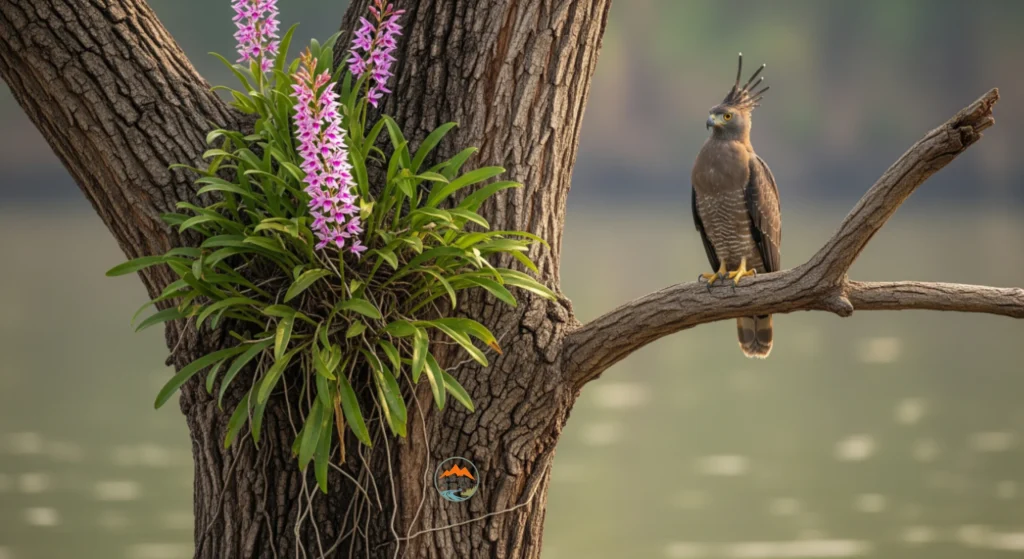
B. Nature’s Other Wonders 🏞️
- Brahmaputra River Experiences: The majestic Brahmaputra River, flowing along the park’s northern boundary, offers more than just scenic views. You can enjoy river cruises and boat rides, with a major highlight being the chance to spot the rare and endangered Gangetic River Dolphins! 🐬
- Kakochang Waterfalls: Tucked away amidst lush greenery between Kaziranga and Bokakhat, Kakochang Waterfalls is a breathtaking natural wonder and a popular picnic spot 🏞️. The cascading waters and vibrant surrounding flora create a soothing ambiance, making it a perfect retreat for nature lovers.
- Hollongapar Gibbon Sanctuary: Located about 110 km from Kaziranga, this sanctuary is the only habitat in India for the Hoolock Gibbon, India’s only ape! 🐒 An early morning hike through the sanctuary offers a unique chance to hear their distinctive calls and observe these primates in their natural habitat. It’s a fantastic blend of adventure and education.
- Majuli Island: Just a short boat ride away on the Brahmaputra River, Majuli is recognized as the world’s largest river island and holds UNESCO World Heritage status 🏝️. It’s a significant cultural hotspot, known for its 31 Satras (Neo-Vaishnavite monastic centers), traditional mask-making art, and stunning landscapes. February is considered an ideal time for visiting Majuli, as the river is calmer, making ferry rides even more enjoyable.
C. Adventure & Exploration 🚴♀️🏛️
- Trekking & Off-road Biking: For all you adventurous souls, offbeat trails around the Karbi Anglong hills offer exciting opportunities for mountain biking and guided trekking trips to hilltops, which boast breathtaking panoramic views of the entire region! 🚴♂️
- Historical & Spiritual Landmarks:
- Deoparbat Ruins: This archaeological site near Numaligarh offers valuable insights into Assam’s ancient civilization, featuring 9th-century temple remains and intricately carved stone structures 🛕.
- Negheriting Shiva Doul: An 8th-century Shiva temple, beautifully rebuilt in 1765, is situated on a tranquil hillock. It’s known for its peaceful ambiance and is home to a sizable population of Rhesus macaques 🐒.
- Burhi Mai Temple: A small temple tucked inside the park’s Western Zone, considered auspicious by locals, offers a quiet cultural pause before embarking on your safari 🙏.
The wide array of “beyond safari” activities around Kaziranga, from cultural parks to historical sites and adventure sports, shows a deliberate effort to diversify the tourism offering and encourage longer stays. This transforms the region from being solely a wildlife destination into a comprehensive regional experience. The development and promotion of these diverse attractions, like the “miniature Assam” at the Orchid Park, cultural performances, and historical sites, truly enhance your overall visit and boost the average length of stay. This diversification directly contributes to broader economic benefits for local communities, extending beyond just safari revenue to cultural tourism, adventure tourism, and local crafts. This transforms Kaziranga from a “wildlife-only” stop into a comprehensive regional destination. This broader tourism strategy contributes significantly to sustainable tourism by spreading visitor impact across different sites and creating varied economic opportunities for local populations, reducing over-reliance on park-centric activities. It also fosters a deeper appreciation for Assam’s rich cultural and natural heritage, encouraging repeat visits and longer, more enriching travel experiences.
V. Where to Stay: Lodging Tips from the Best Kaziranga Guide 🏡
Kaziranga offers a diverse range of accommodations designed to suit every budget and preference, from luxurious resorts to charming homestays, ensuring you have a comfortable and memorable stay. The strong recommendation for advance booking and the variety of accommodation types, including eco-friendly options and homestays, indicate a growing maturity in Kaziranga’s tourism infrastructure, balancing luxury with sustainability and local integration.
A. Accommodation Options 🏨
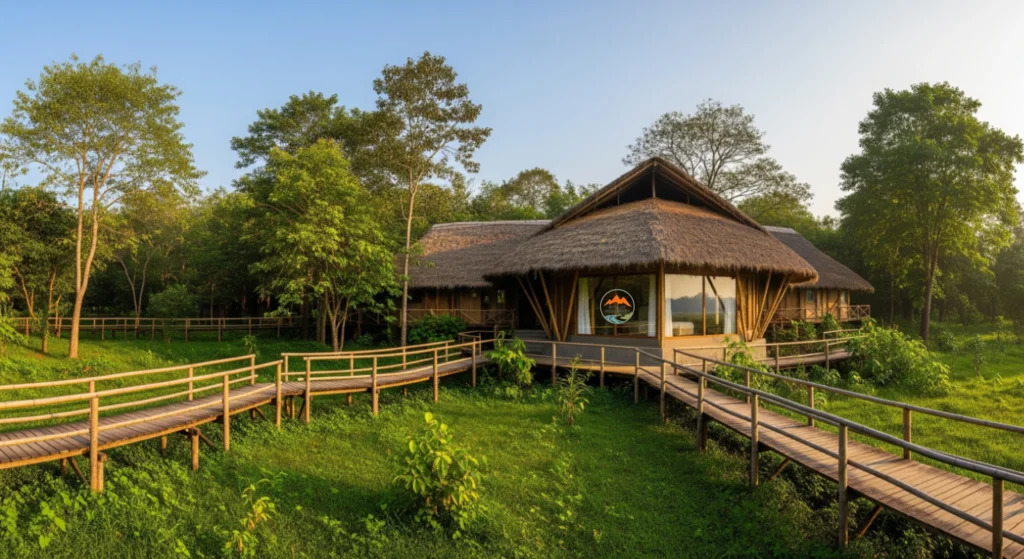
- Luxury Resorts: For those seeking ultimate comfort and premium amenities, highly recommended options include Diphlu River Lodge, IORA – The Retreat , Resort Borgos , Infinity Resort, and Agoratoli Jungalow Resort. These places often feature amazing amenities like spas, multiple restaurants, and swimming pools 🏊♀️. The Kaziranga Address is particularly praised for its exceptionally helpful staff and its excellent, quiet, and scenic location amidst rice fields, making it a perfect place to relax after a safari.
- Mid-Range & Eco-Resorts: Options like Wild Grass Lodge , Bonhabi Resort , and Nature Hunt Eco Camp offer a lovely blend of rustic charm and affordability. Many of these prioritize eco-friendly practices, actively contributing to reforestation and wildlife conservation efforts 🌳. Nature Hunt Eco Camp is noted for its lovely, clean cottages, use of solar power, and delicious, reasonably priced food 😋.
- Homestays & Budget Stays: For a more authentic and budget-friendly experience, homestays like MONIRAMS INN , Homocation Panchami Homestay , and Green Reed Homestay are available throughout different zones of Kaziranga. These allow you to truly experience the cultural essence by living with local families 👨👩👧👦. MONIRAMS INN, for instance, is praised for its homely atmosphere, welcoming hosts who help with safari arrangements, local delicacies, and budget-friendly prices, even during peak season! 💰 Government-run guest houses also provide basic yet comfortable lodging options. Many travelers have shared positive experiences about the hospitality at places like MONIRAMS INN, where hosts go above and beyond to make guests feel at home and facilitate safari bookings. Staying close to the main safari ranges, such as Kohora or Bagori, is a practical tip frequently echoed by visitors, as it significantly cuts down on morning travel time for early safaris.
A range of accommodation options, from luxury resorts to homestays, reflects Kaziranga’s developed tourism market and growing focus on responsible travel. Choosing eco-friendly stays and supporting local communities shows a shift toward sustainability, allowing travelers to align their choices with their values. This commitment enhances Kaziranga’s reputation as a responsible destination and attracts ethically-minded visitors, further promoting sustainable tourism practices.
B. Booking Smart savvy 💡
- Book in Advance: I can’t stress this enough – especially for visits during the peak season (November-April)! Booking 2-3 months prior is crucial to secure your preferred accommodation and avoid disappointment due to high demand.
- Online Platforms vs. Direct Booking: You can use online booking platforms (like Booking.com and Travelocity) to check availability, compare options, and often find great deals. Some properties also offer direct booking, which might occasionally give you better deals or more personalized service.
- Check Inclusions & Amenities: Always double-check what’s included in the nightly rate, like breakfast, parking, or Wi-Fi. Also, look for options with “Free Cancellation” for added flexibility in your travel plans – peace of mind is priceless!
- Read Reviews: Pay close attention to recent reviews from other travelers. They’re a goldmine for gauging service quality, location, and any potential issues.
Here’s a quick reference table for accommodation options:
Accommodation Types & Examples with Key Amenities/Price Notes
| Accommodation Type | Example Properties | Key Amenities | Price Range (Approx. Nightly) |
|---|---|---|---|
| Luxury Resorts | IORA – The Retreat, Resort Borgos, The Kaziranga Address | Spa, multiple restaurants, outdoor pool, premium bedding, excellent service, scenic location | $$$ ($60 – $100+) |
| Mid-Range / Eco-Resorts | Wild Grass Lodge, Bonhabi Resort, Nature Hunt Eco Camp | Rustic charm, eco-friendly practices (solar power, water saving), good food, comfortable cottages | $$ ($35 – $60) |
| Homestays / Budget Stays | MONIRAMS INN, Homocation Panchami Homestay, Green Reed Homestay | Homely feel, local delicacies, welcoming hosts, basic amenities, free parking, cultural immersion | $ ($15 – $35) |
Note: Price ranges are indicative and can vary significantly based on season, booking platform, and specific dates.
VI. Getting There: Travel Routes in the Best Kaziranga Guide ✈️🚂🚗
Reaching Kaziranga National Park is super convenient, thanks to its well-established connections via air, train, and road. This makes it a highly accessible wildlife destination for both domestic and international travelers, directly contributing to its growing visitor numbers.
A. By Air ✈️
- Nearest Airports: Your main aerial gateway to Kaziranga is Lokpriya Gopinath Bordoloi International Airport (LGBI Airport) in Guwahati, situated approximately 220 km from the park. This airport offers connections to major Indian cities. A closer option is Jorhat Airport (Rowroya Airport), which is only about 97 km from Kaziranga – that’s roughly a 1.5-hour road journey to the central tourist hub of Kohora. Flights to Jorhat primarily operate from Guwahati and Kolkata.
B. By Train 🚂
- Nearest Railway Stations: Guwahati serves as a major railway hub, connecting you to significant parts of India. From Guwahati, you can then take a road journey to Kaziranga. Furkating Junction, approximately 75 km from the park, is actually the closest railway station.
C. By Road 🚗
- From Guwahati: The drive from Guwahati to Kaziranga National Park covers about 220 km via National Highway 37, typically taking around 4-5 hours. This drive is often described as scenic, transitioning from urban areas to expansive fields and rolling hills – a beautiful prelude to the wild!
- From Jorhat: The distance from Jorhat to Kohora, Kaziranga, is about 105 km via NH37, with an estimated travel time of 2 hours.
- From Tezpur: From Tezpur, Kaziranga is approximately 90 km away via NH37, also taking about 2 hours by road.
The road journey from Guwahati to Kaziranga is frequently described as “surreal,” flanked by “endless tea gardens” 🌿. This gradual transition from urban bustle to serene landscapes serves as a perfect prelude to your wilderness experience. The ease of accessibility from major travel hubs, such as Guwahati, directly contributes to the increase in tourist footfall, making Kaziranga a key factor in its growth as a popular destination. The scenic road journeys further enhance the overall travel experience, adding to the park’s appeal. This strong connectivity not only boosts tourism revenue for the park but also creates economic benefits for surrounding regions through transport services, local businesses, and accommodation providers. It truly positions Kaziranga as a major player in India’s wildlife tourism landscape, capable of sustaining high visitor volumes.
VII. Capturing the Magic: Photography Tips from the Best Kaziranga Guide 📸
Kaziranga National Park offers unparalleled opportunities for wildlife and landscape photography. To truly capture its magic, understanding optimal conditions and ethical practices is essential.
- Optimal Light Conditions: The “golden hours” of dawn and dusk are ideal for nature photography. Light conditions between 7:30 AM and 9:30 AM and between 3:30 PM and 5:00 PM offer angular, soft, or dramatic side-lit/backlit scenes that truly enhance your photos.
- Patience, Composition, and Respecting Wildlife: Wildlife photography demands immense patience. Close encounters with large wild animals are often brief and unexpected, so you’ll need to wait for that opportune moment. It is paramount to never violate an animal’s space, restrict its movements, or cause any harm. All park rules must be strictly obeyed – no exceptions! When it comes to composition, aim to frame your images beautifully, including a little background to make the subject look natural. Keep your subject at the focal point, aim for that “catch light” in its eye, and experiment with various angles and perspectives – it can significantly improve your results. Enhancing contrast by framing darker subjects against well-lit backgrounds or vice versa can also create dramatic effects.
- Gear Recommendations: A telephoto lens with at least a 400mm focal length is essential for capturing distant wildlife without disturbing them. Carrying a shorter focal length lens is also smart for those breathtaking landscapes that define Kaziranga. To minimize camera shake, especially for landscapes or in challenging conditions, using a tripod, monopod, shoulder pod, or chest pod is highly recommended. And please, bring backup batteries and chargers – you don’t want to miss that critical shot! 🔋 Protecting your equipment from heat, dust, and moisture is also vital for its longevity and performance.
- Specific Tips for Elephant Safari Photography: If you’re photographing from an elephant, remember to account for the steep angle of view and potential camera shake. Use a fast shutter speed, follow the elephant’s rhythm, and capture shots when the animal is steady for better results.
The detailed photography tips, especially regarding optimal light conditions and ethical practices, highlight Kaziranga’s appeal as a premier wildlife photography destination and the park’s commitment to responsible viewing. The provision of such specific advice indicates that wildlife photography is a significant niche tourism segment for Kaziranga. The strong emphasis on “respect wildlife” and “never harm your subject” is not just a set of rules but a core ethical principle embedded in the park’s management and actively promoted to visitors. This encourages you to engage with the environment more thoughtfully, fostering a deeper connection and minimizing disturbance. By actively guiding photographers towards ethical practices, Kaziranga enhances its reputation as a responsible wildlife destination. This also transforms photographers into advocates for conservation, as their stunning, ethically captured images can inspire others and raise awareness about the importance of protecting these vital habitats. Many travelers who have attempted to capture the park’s essence, even through challenging conditions like photographing a rhino through tall grass from an elephant, emphasize the importance of being present and allowing the moment to unfold. As one piece of advice wisely states, “Do not forget to enjoy the forest and its wildlife. Your eye is the best lens and your brain the best hard-disk”. Couldn’t agree more!
VIII. Responsible Tourism: Preserving Kaziranga’s Legacy 💚
To ensure the long-term preservation of Kaziranga National Park’s delicate ecosystem and its incredible wildlife, adopting responsible tourism practices is paramount. The strong emphasis on eco-friendly accommodation, plastic reduction, ethical tours, and cultural respect reflects a proactive approach by Kaziranga’s tourism ecosystem to mitigate human impact and ensure long-term sustainability.
Eco-Friendly Practices 🌱
- Sustainable Accommodation: Choosing eco-friendly lodges or homestays within or near Kaziranga National Park is highly encouraged. These accommodations often use renewable energy sources and implement water-saving measures. By staying at such places, you directly contribute financially to reforestation and wildlife conservation efforts, thereby supporting local communities.
- Minimize Plastic Use: Plastic pollution is a significant threat to Kaziranga Park’s wildlife and natural environment, as discarded plastic can block waterways, harm animals, and degrade the ecosystem 🗑️. To combat this, you are urged to bring reusable water bottles, carry cloth or jute bags instead of plastic ones, and use reusable utensils during your journey – every little bit helps!
- Travel Off-Peak: Consider visiting during off-peak times, particularly in March and April. This can help reduce the overall pressure on the park’s ecosystem, thereby supporting eco-tourism initiatives.
- Opt for Responsible Wildlife Tours: It’s crucial to select tour operators who prioritize animal welfare and stick to ethical guidelines. Operators providing elephant safari experiences, for instance, should focus on minimizing harm to animals and employ trained guides who educate visitors about wildlife, encouraging respectful observation over rushed photography 🐘.
Respecting Local Cultures and the Environment 🤝
- Cultural Sensitivity: Respecting the traditions and customs of local communities is essential. Always ask for permission before taking pictures of individuals and be mindful of local customs, like removing shoes before entering homes or temples.
- Environmental Stewardship: Strict adherence to environmental stewardship is vital. You must refrain from littering, stay on designated trails, and never harm plants or wild animals. Your individual actions directly impact the park’s delicate ecosystem.
The growing awareness around responsible tourism is a positive development, with many travelers actively seeking out homestays and eco-lodges, eager to contribute positively to the local economy and conservation efforts. This serves as a powerful reminder that the enjoyment of these natural wonders comes with a profound responsibility to protect them for future generations. The detailed nature of these responsible tourism tips suggests that park authorities and associated tourism bodies are not just reacting to problems but are proactively educating visitors and shaping visitor behavior towards sustainability. This also indicates a growing market for ethical tourism, where operators are responding to traveler demand for responsible experiences. This proactive stance fosters a more positive impact on the environment and local communities, moving beyond simple visitation to active contribution. By championing responsible tourism, Kaziranga positions itself as a leader in sustainable wildlife conservation, attracting a conscientious traveler base. This commitment ensures the park’s long-term ecological viability and the continued well-being of its wildlife and surrounding communities, setting a precedent for other global wildlife destinations.
Conclusion: Why the Best Kaziranga Guide Leaves You Transformed ✨
Kaziranga National Park is so much more than just a destination; it’s an immersive experience that seamlessly blends unparalleled wildlife viewing, rich cultural encounters, and breathtaking natural beauty. From the triumphant story of the one-horned rhinoceros – a true testament to dedicated conservation efforts – to the vibrant tapestry of its diverse ecosystems and the warmth of Assamese culture, every single aspect of Kaziranga leaves an indelible impression on its visitors.
The park’s unique geographical setting, shaped by the dynamic Brahmaputra River and bordered by the Karbi Anglong Hills, creates a robust and ever-evolving habitat that supports an extraordinary array of species, including the “Big 5” and a multitude of birds. The nuanced history of its conservation, marked by shifts from inclusive community engagement to stringent protection, offers valuable lessons for global wildlife management.
Planning your visit during the optimal window of November to February will maximize your wildlife sightings, though the quieter months of March and April offer their own charm with lush greenery and fewer crowds. No matter when you go, careful advance booking for safaris and accommodations is crucial, reflecting the park’s popularity and its commitment to managing visitor flow for ecological integrity.
Beyond the thrilling jeep and majestic elephant safaris, Kaziranga invites you to explore deeper through its cultural gems like the Orchid and Biodiversity Park, the serene tea gardens, and opportunities for river cruises to spot Gangetic dolphins. The region also offers exciting adventure activities such as trekking and visits to historical sites, enriching your overall travel experience and supporting local economies.
The growing emphasis on responsible tourism practices within Kaziranga’s ecosystem underscores a collective commitment to sustainability. By choosing eco-friendly accommodations, minimizing plastic use, and respecting local cultures and the environment, you become an active participant in preserving this natural treasure for generations to come.
For many, a journey to Kaziranga National Park is soul-stirring, fostering a profound connection with the wild world and serving as a powerful reminder of nature’s resilience and beauty. Whether the aspiration is a close encounter with a rhino, capturing the perfect photograph of a rare bird, or simply immersing oneself in the tranquility of the Brahmaputra floodplains, Kaziranga promises an adventure unlike any other. So, plan wisely, travel responsibly, and prepare to be amazed! ✨
Official site of Kaziranga National Park: https://www.kaziranga-national-park.com/
You may also like Pobitora Like Never Before: The Ultimate Wildlife Treasure Guide
Ready to embark on your own Kaziranga adventure? Share your travel dreams with us! 🌍

